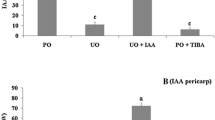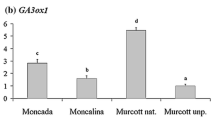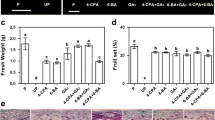Abstract
The response of unpollinated ovary explants ofPisum sativum L. cv. Alaska No. 7 to several plant growth regulators and nutrients has been studied. Explants consisted of a segment of stem and an emasculated flower with or without the adjacent leaf. They were made on the day equivalent to anthesis and were cultured in a liquid medium. Growth regulators were applied either in the solution or directly to the ovaries. Giberellic acid (GA3) in the presence of sucrose, but not indole-3-acetic acid or N6-(Δ2-isopentenyl)-adenine (2iP), induced fruit set and development of parthenocarpic fruits, the final length of these being a function of the intensity of the GA3 treatment. The capacity of ovaries to respond fully to GA3 was not lost after incubation of explants in water or 50 mM sucrose for 1 day and was similar in explants made between the day of anthesis and 3 days later. Limited growth was obtained with 100 mM sucrose alone but this effect was counteracted by 2′-isopropyl-4′-(trimethyl ammonium chloride)-5′-methylphenyl piperidine-1-carboxylate (AMO-1618). This inhibitor was ineffective when GA3 was applied to the ovary. The development of the fruit was proportional to the length of the segment of stem up to 5 cm. The presence of the leaf in the explant enhanced the development of the fruit. These results indicate that a gibberellin is necessary for setting and development of fruits from cultured ovaries and that this effect depends on an appropriate source of nutrients. The course of development of parthenocarpic fruits on explants was similar to that of seeded fruits on the intact plant. The cultured pea ovary systemoffers convenient means to investigate the role of gibberellins and nutrients in fruit set and development.
Similar content being viewed by others
References
Baldev B, Lang A, Agatep AO (1965) Gibberellin production in pea seeds developing in excised pods: Effect of growth retardant AMO-1618. Science 147:155–156
Carbonell J, García-Martínez JL (1980) Fruit-set of unpollinated ovaries ofPisum sativum · L. Influence of vegetative parts. Planta 147:444–450
Dennis DT, Upper CD, West CA (1965) An enzymatic site of inhibition of gibberellin biosynthesis by AMO-1618 and other plant growth retardants. Plant Physiol 40:948–952
García-Martínez JL, Carbonell J (1980) Fruit-set of unpollinated ovaries ofPisum sativum L. Influence of plant-growth regulators. Planta 147:451–456
Jones RL (1973) Gibberellins: Their physiological role. Annu Rev Plant Physiol 24:571–598
Jong AW de, Bruinsma J (1974) Pistil development inCleome flowers. III. Effects of growth-regulating substances on flower-buds ofCleome iberidella Walw. ex Oliv. grownin vitro. Z Pflanzenphysiol 73:142–151
Jong AW de, Smit AL, Bruinsma J (1974) Pistil development inCleome flowers. II. Effects of nutrients on flower buds ofCleoma iberidella Walw. ex Oliv. grownin vitro. Z Pflanzenphysiol 72:227–236
Kano Y, Asahira T (1978) Effects of some plant growth regulators on the development of straberry fruitsin vitro culture. J Jpn Soc Hortic Sci 47:195–202
Kaufman PB, Ghosheh NS, Lacroix JD, Soni SL, Ikuma H (1973) Regulation of invertase levels inAvena stem segments by gibberellic acid, sucrose, glucose, and fructose. Plant Physiol 52:221–228
Leopold AC, Scott FI (1952) Physiological factors in tomato fruit-set. Am J Bot 39:310–317
Nitsch JP (1951) Growth and developmentin vitro of excised ovaries. Am J Bot 38:566–577
Peterson CM (1974) The effects of gibberellic acid and growth retardant on ovule formation and growth of excised pistils ofNigella (Ranunculaceae). Am J Bot 61:693–698
Seitz K, Lang A (1968) Invertase activity and cell growth in lentil epicotyls. Plant Physiol 43:1075–1082
Sponsel VM (1982) Effects of applied gibberellins and naphthylacetic acid on pod development in fruits ofPisum sativum L. cv. Progress No. 9. J Plant Growth Regul 1:147–152
Srivastava PS, Varga A, Bruinsma J (1980) Growthin vitro of fertilized ovules of pea,Pisum sativum L., with and without pods. Z Pflanzenphysiol 98:347–354
Van Staden J, Button J (1978) The cytokinin content of aseptically cultured pea fruits. Z Pflanzenphysiol 87:129–135
Vercher Y, Molowny A, López C, García-Martínez JL, Carbonell J (1984) Structural changes in the ovary ofPisum sativum L. induced by pollination and gibberellin acid. Plant Sci Lett 36:87–91
Walker RR, Hawker JS (1976) Effect of pollination on carbohydrate metabolism in young fruits ofCitrullus lanatus andCapsicuum annuum. Phytochemistry 15:1881–1884
Wittenbach WA, Bukovac MJ (1980)In vitro culture of sour cherry fruits. J Am Soc Hortic Sci 105:277–279
Author information
Authors and Affiliations
Rights and permissions
About this article
Cite this article
García-Martínez, J.L., Carbonell, J. Induction of fruit set and development in pea ovary explants by gibberellic acid. J Plant Growth Regul 4, 19–27 (1985). https://doi.org/10.1007/BF02266940
Received:
Accepted:
Issue Date:
DOI: https://doi.org/10.1007/BF02266940




